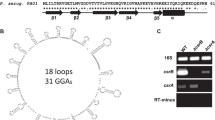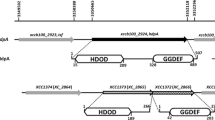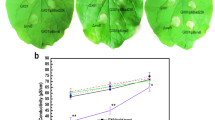Abstract
The bacterial enhancer binding protein (bEBP) HrpS is essential for Erwinia amylovora virulence by activating the type III secretion system (T3SS). However, how the hrpS gene is regulated remains poorly understood in E. amylovora. In this study, 5′ rapid amplification of cDNA ends and promoter deletion analyses showed that the hrpS gene contains two promoters driven by HrpX/HrpY and the Rcs phosphorelay system, respectively. Electrophoretic mobility shift and gene expression assays demonstrated that integration host factor IHF positively regulates hrpS expression through directly binding the hrpX promoter and positively regulating hrpX/hrpY expression. Moreover, hrpX expression was down-regulated in the relA/spoT ((p)ppGpp-deficient) mutant and the dksA mutant, but up-regulated when the wild-type strain was treated with serine hydroxamate, which induced (p)ppGpp-mediated stringent response. Furthermore, the csrA mutant showed significantly reduced transcripts of major hrpS activators, including the hrpX/hrpY, rcsA and rcsB genes, indicating that CsrA is required for full hrpS expression. On the other hand, the csrB mutant exhibited up-regulation of the rcsA and rcsB genes, and hrpS expression was largely diminished in the csrB/rcsB mutant, indicating that the Rcs system is mainly responsible for the increased hrpS expression in the csrB mutant. These findings suggest that E. amylovora recruits multiple stimuli-sensing systems, including HrpX/HrpY, the Rcs phosphorelay system and the Gac–Csr system, to regulate hrpS and T3SS gene expression.






Similar content being viewed by others
References
Ancona V, Li W, Zhao Y (2014) Alternative sigma factor RpoN and its modulation protein YhbH are indispensable for Erwinia amylovora virulence. Mol Plant Pathol 15:58–66
Ancona V, Chatnaparat T, Zhao Y (2015a) Conserved aspartate and lysine residues of RcsB are required for amylovoran biosynthesis, virulence, and DNA binding in Erwinia amylovora. Mol Genet Genomics 290:1265–1276
Ancona V, Lee JH, Chatnaparat T, Oh J, Hong JI, Zhao Y (2015b) The bacterial alarmone (p)ppGpp activates the type III secretion system in Erwinia amylovora. J Bacteriol 197:1433–1443
Ancona V, Lee JH, Zhao Y (2016) The RNA-binding protein CsrA plays a central role in positively regulating virulence factors in Erwinia amylovora. Sci Rep 6:37195
Bretz J, Losada L, Lisboa K, Hutcheson SW (2002) Lon protease functions as a negative regulator of type III protein secretion in Pseudomonas syringae. Mol Microbiol 45:397–409
Bush M, Dixon R (2012) The role of bacterial enhancer binding proteins as specialized activators of σ54-dependent transcription. Microbiol Mol Biol Rev 76:497–529
Büttner D (2012) Protein export according to schedule: architecture, assembly, and regulation of type III secretion systems from plant-and animal-pathogenic bacteria. Microbiol Mol Biol Rev 76:262–310
Dalebroux ZD, Swanson MS (2012) ppGpp: magic beyond RNA polymerase. Nat Rev Microbiol 10:203–212
Dixon R (1998) The oxygen-responsive NIFL-NIFA complex: a novel two-component regulatory system controlling nitrogenase synthesis in γ-proteobacteria. Arch Microbiol 169:371–380
Edmunds AC, Castiblanco LF, Sundin GW, Waters CM (2013) Cyclic Di-GMP modulates the disease progression of Erwinia amylovora. J Bacteriol 195:2155–2165
Elderkin S, Jones S, Schumacher J, Studholme D, Buck M (2002) Mechanism of action of the Escherichia coli phage shock protein PspA in repression of the AAA family transcription factor PspF. J Mol Biol 320:23–37
Guo Y, Lew CM, Gralla JD (2000) Promoter opening by σ54 and σ70 RNA polymerases: sigma factor-directed alterations in the mechanism and tightness of control. Genes Dev 14:2242–2255
Hauryliuk V, Atkinson GC, Murakami KS, Tenson T, Gerdes K (2015) Recent functional insights into the role of (p)ppGpp in bacterial physiology. Nat Rev Microbiol 13:298–309
Henry JT, Crosson S (2011) Ligand-binding PAS domains in a genomic, cellular, and structural context. Annu Rev Microbiol 65:261–286
Huang YC, Lin YC, Wei CF, Deng WL, Huang HC (2016) The pathogenicity factor HrpF interacts with HrpA and HrpG to modulate type III secretion system (T3SS) function and t3ss expression in Pseudomonas syringae pv. averrhoi. Mol Plant Pathol 17:1080–1094
Jovanovic M, James EH, Burrows PC, Rego FG, Buck M, Schumacher J (2011) Regulation of the co-evolved HrpR and HrpS AAA+ proteins required for Pseudomonas syringae pathogenicity. Nat Commun 2:177
Kalia D, Merey G, Nakayama S, Zheng Y, Zhou J, Luo Y, Guo M, Roembke BT, Sintim HO (2013) Nucleotide, c-di-GMP, c-di-AMP, cGMP, cAMP, (p)ppGpp signaling in bacteria and implications in pathogenesis. Chem Soc Rev 42:305–341
Koczan JM, McGrath MJ, Zhao Y, Sundin GW (2009) Contribution of Erwinia amylovora exopolysaccharides amylovoran and levan to biofilm formation: implications in pathogenicity. Phytopathol 99:1237–1244
Lee JH, Zhao Y (2016) Integration host factor is required for RpoN-dependent hrpL gene expression and controls motility by positively regulating rsmB sRNA in Erwinia amylovora. Phytopathol 106:29–36
Lee JH, Sundin GW, Zhao Y (2016) Identification of the HrpS binding site in the hrpL promoter and effect of the RpoN binding site of HrpS on the regulation of the type III secretion system in Erwinia amylovora. Mol Plant Pathol 17:691–702
Lee JH, Ancona V, Zhao Y (2017) Lon protease modulates virulence traits in Erwinia amylovora by directly monitoring major regulators and indirectly through the Rcs and Gac-Csr regulatory systems. Mol Plant Pathol. doi:10.1111/mpp.12566
Li W, Ancona V, Zhao Y (2014) Co-regulation of polysaccharide production, motility, and expression of type III secretion genes by EnvZ/OmpR and GrrS/GrrA systems in Erwinia amylovora. Mol Genet Genomics 289:63–75
Mascher T (2013) Signaling diversity and evolution of extracytoplasmic function (ECF) σ factors. Curr Opin Microbiol 16:148–155
McNally R, Toth IK, Cock PJA, Pritchard L, Hedley PE, Morris JA, Zhao YF, Sundin GW (2012) Genetic characterization of the HrpL regulon of the fire blight pathogen Erwinia amylovora reveals novel virulence factors. Mol Plant Pathol 13:160–173
Merighi M, Majerczak DR, Stover EH, Coplin DL (2003) The HrpX/HrpY two-component system activates hrpS expression, the first step in the regulatory cascade controlling the Hrp regulon in Pantoea stewartii subsp. stewartii. Mol Plant Microbe Interact 16:238–248
Merighi M, Majerczak DR, Zianni M, Tessanne K, Coplin DL (2006) Molecular characterization of Pantoea stewartii subsp. stewartii HrpY, a conserved response regulator of the Hrp type III secretion system, and its interaction with the hrpS promoter. J Bacteriol 188:5089–5100
Miller JH (1972) Assay of β-galactosidase. In: Experiments in molecular genetics. Cold Spring Harbor Laboratory, NY, pp 352–355
Oh CS, Beer SV (2005) Molecular genetics of Erwinia amylovora involved in the development of fire blight. FEMS Microbiol Lett 253:185–192
Ortiz-Martín I, Thwaites R, Macho AP, Mansfield JW, Beuzón CR (2010) Positive regulation of the Hrp type III secretion system in Pseudomonas syringae pv. phaseolicola. Mol Plant-Microbe Interact 23:665–681
Parales RE, Harwood CS (1993) Construction and use of a new broad-host-range lacZ transcriptional fusion vector, pHRP309, for Gram− bacteria. Gene 133:23–30
Potrykus K, Cashel M (2008) (p)ppGpp: still magical? Annu Rev Microbiol 62:35–51
Preston G, Deng WL, Huang HC, Collmer A (1998) Negative regulation of hrp genes in Pseudomonas syringae by HrpV. J Bacteriol 180:4532–4537
Slauch JM, Silhavy TJ (1991) cis-acting ompF mutations that result in OmpR-dependent constitutive expression. J Bacteriol 173:4039–4048
Ueta M, Yoshida H, Wada C, Baba T, Mori H, Wada A (2005) Ribosome binding proteins YhbH and YfiA have opposite functions during 100S formation in the stationary phase of Escherichia coli. Genes Cells 10:1103–1112
Wang D, Korban SS, Zhao Y (2009) The Rcs phosphorelay system is essential for pathogenicity in Erwinia amylovora. Mol Plant Pathol 10:277–290
Wei ZM, Beer SV (1995) HrpL activates Erwinia amylovora hrp gene transcription and is a member of the ECF subfamily of s factors. J Bacteriol 177:6201–6210
Wei ZM, Sneath BJ, Beer SV (1992) Expression of Erwinia amylovora hrp genes in response to environmental stimuli. J Bacteriol 174:1875–1882
Wei Z, Kim JF, Beer SV (2000) Regulation of hrp genes and type III protein secretion in Erwinia amylovora by HrpX/HrpY, a novel two-component system, and HrpS. Mol Plant-Microbe Interact 13:1251–1262
Wei CF, Deng WL, Huang HC (2005) A chaperone-like HrpG protein acts as a suppressor of HrpV in regulation of the Pseudomonas syringae pv. syringae type III secretion system. Mol Microbiol 57:520–536
Yang F, Korban SS, Pusey PL, Elofsson M, Sundin GW, Zhao Y (2014) Small-molecule inhibitors suppress the expression of both type III secretion and amylovoran biosynthesis genes in Erwinia amylovora. Mol Plant Pathol 15:44–57
Yap MN, Yang CH, Barak JD, Jahn CE, Charkowski AO (2005) The Erwinia chrysanthemi type III secretion system is required for multicellular behavior. J Bacteriol 187:639–648
Yap MN, Yang CH, Charkowski AO (2008) The response regulator HrpY of Dickeya dadantii 3937 regulates virulence genes not linked to the hrp cluster. Mol Plant Microbe Interact 21:304–314
Zeng Q, McNally RR, Sundin GW (2013) Global small RNA chaperone Hfq and regulatory small RNAs are important virulence regulators in Erwinia amylovora. J Bacteriol 195:1706–1717
Zere TR, Vakulskas CA, Leng Y, Pannuri A, Potts AH, Dias R, Tang D, Kolaczkowski B, Georgellis D, Ahmer BMM, Romeo T (2015) Genomic targets and features of BarA-UvrY (-SirA) signal transduction systems. PLoS One 10:e0145035
Zhao Y (2014) Genomics of Erwinia amylovora and related Erwinia species associated with pome fruit trees. In: Gross D, Lichens-Park A, Kole C (eds) Genomics of plant-associated bacteria. Springer, Berlin
Zhao Y, Wang D, Nakka S, Sundin GW, Korban SS (2009) Systems level analysis of two-component signal transduction systems in Erwinia amylovora: role in virulence, regulation of amylovoran biosynthesis and swarming motility. BMC Genomics 10:245
Author information
Authors and Affiliations
Corresponding author
Ethics declarations
Funding
This project was supported by the Agriculture and Food Research Initiative Competitive Grants Program Grant no. 2016-67013-24812 from the USDA National Institute of Food and Agriculture.
Conflict of interest
Both authors have no conflicts of interest to declare.
Ethical approval
This article does not contain any studies with human participants or animals performed by any of the authors.
Additional information
Communicated by S. Hohmann.
Electronic supplementary material
Below is the link to the electronic supplementary material.
Rights and permissions
About this article
Cite this article
Lee, J.H., Zhao, Y. Integration of multiple stimuli-sensing systems to regulate HrpS and type III secretion system in Erwinia amylovora . Mol Genet Genomics 293, 187–196 (2018). https://doi.org/10.1007/s00438-017-1376-3
Received:
Accepted:
Published:
Issue Date:
DOI: https://doi.org/10.1007/s00438-017-1376-3




